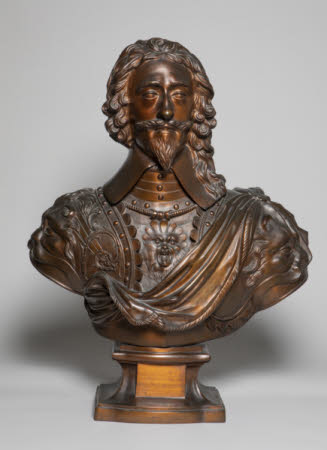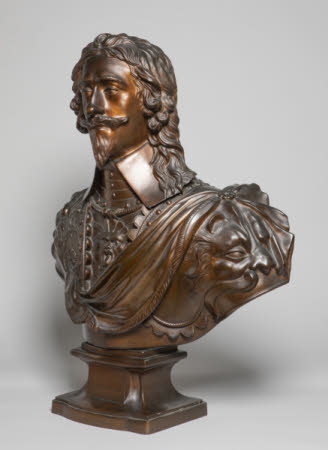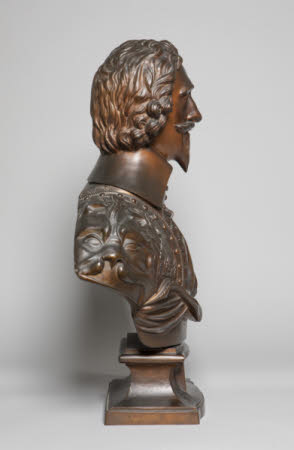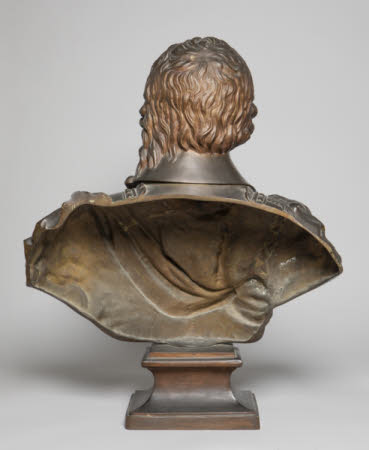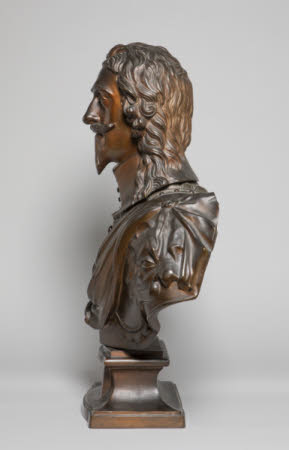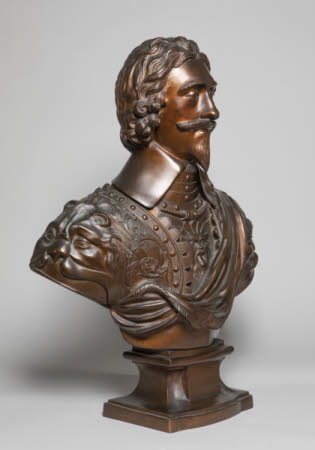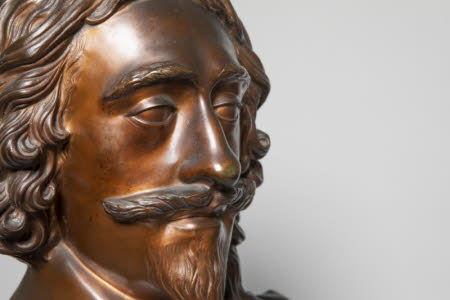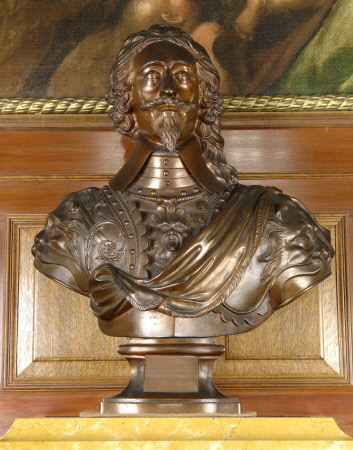Portrait bust of Charles I (1600-1649), King of England, Scotland and Ireland
Torbier jeune (fl. c.1838 - 1845)
Category
Art / Sculpture
Date
1838 - 1839
Materials
Bronze
Measurements
780 x 630 mm; 290 mm (Width)
Place of origin
Paris
Order this imageCollection
Kingston Lacy Estate, Dorset
NT 1255241
Summary
Sculpture, bronze; Portrait bust of King Charles I; after Hubert le Sueur (c. 1585-1658), cast by Torbier jeune (fl. c. 1838-45); 1838-39. A copy of a portrait bust of Charles I, King of England, Scotland and Ireland (1600-1649), by his court sculptor Hubert le Sueur. The copy, executed in a Parisian foundry in 1838-39, was ordered by William Bankes as part of his early plan to create for display at Kingston Lacy a series of portrait busts of his ancestors. King Charles would have been included because of the family’s loyalty to the Crown during the Civil War, notably Lady Bankes’s famous defence of Corfe Castle against Parliamentarian forces.
Full description
A bronze portrait bust of King Charles I (166-1649), after a model by Hubert Le Sueur (1580-1658). The monarch is depicted facing forwards, his hair long and tumbling in curls over his collar, with a small goatee beard and upturned moustache. He wears armour with a screaming mask on the corselet and lion’s head pauldrons at the shoulders, whilst at the throat a stiff collar overlaps the gorget. A cloak, fixed at the left shoulder with a clasp in the form of a stylised flower, runs over the left shoulder and under the right shoulder. The king’s hair tumbles on to his shoulder at left. Mounted on a socle with a blank tablet at the front. The bust is made in three sections, the head and collar, bust section and the socle. The head and bust sections are joined with screws and nuts, visible from behind, whilst the bust section is likewise fixed to the socle by means of three screws and nuts. The surfaces of the bust have been extremely carefully worked, the armour matted, perhaps in the wax model. A golden patination applied to the surfaces. The bust is a copy, made in late 1838, of a portrait bust of King Charles I by his court sculptor Hubert le Sueur. The son of a Parisian master-armourer, Le Sueur was first recorded as working in Paris as a sculptor in 1604 and by 1612 was working for the French royal family. After the marriage in May 1625 of the French king Louis XIII’s sister Henrietta Maria to Charles I, king of England, Scotland and Ireland, Hubert le Sueur seems to have been summoned to London to work for the new king, whom he served as court sculptor until the outbreak of the Civil War. After hostiloities had begun, Le Sueur quickly returned to France to resume his career across the Channel. Throughout his career he was more highly regarded for his proficiency as a bronze founder than for his imaginative powers. Whilst working for Charles, Hubert le Sueur made a number of portraits of the monarch, as well as some of his queen. His busts of King Charles I, which invariably show the king wearing armour, are in the well-established tradition of European royal portrait sculpture. The best are competent efforts, although they hardly begin to approach the brilliance of contemporary Roman Baroque sculptors such as Gian Lorenzo Bernini or Alessandro Algardi. One of the very best of these portraits of king Charles I is the unique bust at Stourhead (NT 731855), whilst at Ickworth there is a fine small version (NT 850841) of Le Sueur’s bronze equestrian portrait of the king that has, since the late seventeenth century, stood in Trafalgar Square. The bust at Kingston Lacy is an accurate copy of a model that was in existence by 1635 or 1636, when Archbishop Laud presented an excellent version to the Bodleian Library in Oxford, where it still presides over the entrance to the historic Duke Humfrey's Library (Avery 1982, cat. 30b, Pl. 55a). In this particular model, the king’s armour is notable for its very high throat piece (gorget) over which project the enormous linen collars of his undershirt, whilst his shoulders are protected by prominent pauldrons (shoulder pieces) in the form of lion masks. The cloak draped over the front and fastened at the left shoulder adds a Baroque touch. As well as the version in Oxford, other contemporary casts of this bust type to survive include those at Woburn Abbey and in the Royal Collection (RCIN 33467), possibly identifiable with one of the three busts of the king by Le Sueur that were recorded in an inventory of Whitehall Palace made in 1639, shortly before the outbreak of the Civil War. Other examples of these busts must have existed, many destroyed in the years following the execution of Charles I in 1649, when the Parliamentary authorities sought to expunge symbols of royalty, especially from public places. One example is very likely to have been known to William Bankes as a young boy (Hallam Smith and Crook 2022, pp. 402-05, fig. 14). Originally placed in Westminster Hall it suffered inevitable removal during the Commonwealth and then was moved around various locations,and was discussed in 1740 by George Vertue, who had seen it when it in the clerk of works office (Howarth 1989, p. 112, note 119). In 1791 the bust was removed from a dark corner of Westminster Hall to the passageway from the Hall to Old Palace Yard, where the Bankes’s had their London house. It was evidently regarded by many at this time as the work of the famous Roman sculptor Gianlorenzo Bernini, whose marble bust of King Charles I had been destroyed in the 1698 fire in Whitehall Palace. Thus the bust was famous enough to feature in the 3rd edition of Thomas Pennant’s guidebook, in which it was even illustrated as the frontispiece, engraved by Henry Brocas (Pennant 1791, p. 94). Brocas’s print and another engraving of the bust by Peter Mazell (1733-1802), examples of which are in the Royal Collection (RCIN 601957 601959), show that the bustwas clearly by Le Sueur, and was very close in form to the bust now at Kingston Lacy. It seems to have disappeared by 1800, so was only visible in Old Palace Yard for a few years. The Kingston Lacy bust is a much later cast, one of a group of copies of the model that may have all been made in Paris in the 1830s or 1840s. As well as the Kingston Lacy bust, there is another at The Vyne, Hampshire (NT 719099), acquired c. 1845-47, one in the Victoria & Albert Museum (Inv. A.12-1937; Bilbey and Trusted 2002, no. 22) and another in the National Portrait Gallery, London (NPG 297), acquired in 1870. Yet another is in the Bode Museum in Berlin. The busts are slightly simplified versions of the Bodleian type, for example lacking the medal of Saint George present in the Oxford bust. All have an identical socle, bowed and with a blank tablet at the front. The are minor differences between the different casts, for example the decoration of the gorget section of the armour. Likewise, the eyes in the Kingston Lacy bust are blank, whereas in the version in the V&A the pupils and iris are incised. The Kingston Lacy bust was made in Paris, in the latter months of 1838. We know this thanks to a letter of 3 January 1839 to William Bankes, from a M. Tenison (Dorset History Centre, Bankes Archive, H/J/1/521). Although the letter is written in French, the writer was probably a member of the distinguished Anglo-Irish Tenison family, presumably one of the numerous wealthy Britons (among them Richard Seymour-Conway, 4th Marquess of Hertford, whose collections became the Wallace Collection) who chose to make their home in the more anonymous and socially liberal environment of the French capital, in the decades after the end of the Napoleonic wars. In his letter Tenison informs William Bankes that Lord Elgin (Thomas Bruce, seventh earl of Elgin and eleventh earl of Kincardine, 1766–1841), who was responsible for the arrival of the Parthenon marbles to Britain, was now ‘among our number’ (‘est des nôtres’), presumably meaning a group of English-speaking voluntary exiles living in the city. Encumbered with debts, Elgin did indeed find refuge in Paris in his last years, dying in the city in 1841. Tenison seems to have been charged with supervising the making of the bust of Charles I, informing Bankes that it had been completed and would be sent in the course of the week by the founder, whom he names as a ‘M Torbier’. Torbier appears as ‘Torbier jeune’ in a couple of Parisian trade directories in the years around 1840: in the Almanach général des commerçans de Paris et des départemens for 1840, listed (p. 449) as a ‘fabricant de bronzes’ with an address at rue Menilmontant 32, and then in the Annuaire général du commerce, de l'industrie, de la magistrature et de l'administration for 1845, with the address of Faubourg-du-Temple 25 (pp. 376, 431). Otherwise nothing is known about this artist, one of hundreds of bronze founders and workers active in Paris at this time. But there is no doubt of his skill. The surfaces of the bust are extremely carefully afterworked with chisels, hammers and other tools, even though in his letter Tenison claimed that Torbier had not dared to attempt to work up the surfaces further, since that level of detail was absent from the model from which he was working (‘Je presume que vous serez satisfait de son travail, quoique susceptible d’un plus grand fini, il n’a pas osé hazarder des details, qu’il n’avait pas à emprunter à son modèle’). Tenison must have taken a very close interest in the progress of the making of the bronze, continuing that he did not think its ‘Florentine’ patination very happy, but that he had been advised that it would soon darken (‘La teinte du “bronze florentin” ne m’a pas paru heureuse; l’on m’a fait observer, quoique j’y trouvais à réprendre, ne tarderait point à se modifier, et que dans très peu de tems d’içi je la verrai se rembrunir considérablement.’). It is generally assumed that these busts were made using a cast in plaster taken from the bronze bust in the Bodleian Library, which is certainly possible, although the Bodleian bust was not particularly accessible and other examples had been on the market – including the one in the Royal Collection, acquired by king George IV only in around 1820. It is also possible that the version of the bust formerly in Westminster Hall, which is close to these copies than the Bodleian portrait, could have served as the model. There was increased demand for images of Charles I in the decades following the end of the Napoleonic wars, when his tragic story joined the stable of popular subjects for writers and artists during the Romantic period, not just in Britain but also in France – among the masterpieces of the French painter Paul Delaroche (1797-1856) was his recently rediscovered and enormous painting of Charles I insulted, shown to acclaim at the Paris Salon in 1837. There would therefore have been a demand for images of the monarch not just in London but also in Paris, helping to explain how a cast of Le Sueur’s portrait might have made its way across the Channel. It would seem very likely that the commissioning in Paris of the copy of the bust of King Charles I was facilitated by Baron Carlo Marochetti (1805-1867), who was living in Paris in the 1830s and who in 1840 would be much helped by William Bankes in his campaign to obtain the major commission for the equestrian monument to the Duke of Wellington for the city of Glasgow (for discussion of Bankes’s role in this commission, see NT 1255215). Indeed the bust was at one time attributed to the sculptor. Marochetti and Bankes may have met in Paris in 1838, the year in which the sculptor’s first great success, his equestrian monument to Emanuele Filiberto, Duke of Savoy, was installed on Piazza San Carlo in his home city of Turin. M. Tenison must also have been an intimate friend of the sculptor, since he finished his letter by saying that ‘Baron Marcochetti, who has surprised me as I sit pen in hand…’, wished to be remembered to Bankes (‘le Baron Marochetti, qui me surprend la plume à la main, veut être rapelée ä votre bon souvenir’). The reference strongly suggests that Bankes had come to know Marochetti whilst in Paris in 1838, when he had given instructions for the making of the bust of Charles I. Among the most spectacular sculptures at Kingston Lacy today are the full-length statues of William Banke’s ancestors Sir John and Lady Bankes, made in the early 1850s and placed on the staircase landing to either side of a seated figure of King Charles (NT 1255195.1-3), the king being included because of Sir John’s position as Charles I’s Attorney-General and, in particular, Lady Bankes’s valiant defence of the Royalist cause during the siege of Corfe Castle. However, in the 1830s William Bankes seems to have first contemplated celebrating his illustrious ancestors primarily through the creation of a series of portrait busts, to have been displayed in the Entrance Hall at Kingston Lacy. The only ones that were made were the present bust of king Charles I and two bronze portrait busts of Sir John Bankes by Marochetti (NT 1255240.1-2), that were based on a plaster cast from another work by Hubert Le Sueur, the effigy from the monument to Sir Thomas Richardson, in Westminster Abbey (see NT 1257712). Jeremy Warren February 2025
Provenance
Commissioned by William John Bankes (1786-1855) in 1838; by descent to Ralph Bankes (1902-1981); bequeathed in 1981.
Makers and roles
Torbier jeune (fl. c.1838 - 1845), caster after Hubert Le Sueur (c.1580 - Paris 1658), sculptor previously ascribed to Baron Carlo Marochetti, RA (Turin 1805 – Passy, Paris 1867), sculptor
References
Pennant, Thomas, 1726-1798 Of London Some account of London. MDCCXCI [1791] Avery 1982: Charles Avery, 'Hubert Le Sueur, the 'unworthy Praxiteles' of King Charles I', The Walpole Society, Vol. 48 (1980-82), pp. 135-209 Howarth 1989: David Howarth, ‘Charles I, Sculpture and Sculptors’ in Arthur MacGregor (ed.), The Late King’s Goods. Collections, Possessions and Patronage of Charles I in the light of the Commonwealth Sale Inventories, London and Oxford 1989, pp. 73-113 Bilbey and Trusted 2002: Diane Bilbey and Marjorie Trusted, British Sculpture 1470 to 2000, A Concise Catalogue of the Collection at the Victoria and Albert Museum, London 2002 Hallam Smith and Crook 2022: Elizabeth Hallam Smith and John Crook, ‘Westminster Hall’s lost Stuart door passage rediscovered’, The Antiquaries Journal, 102 (2022), pp. 389-417
